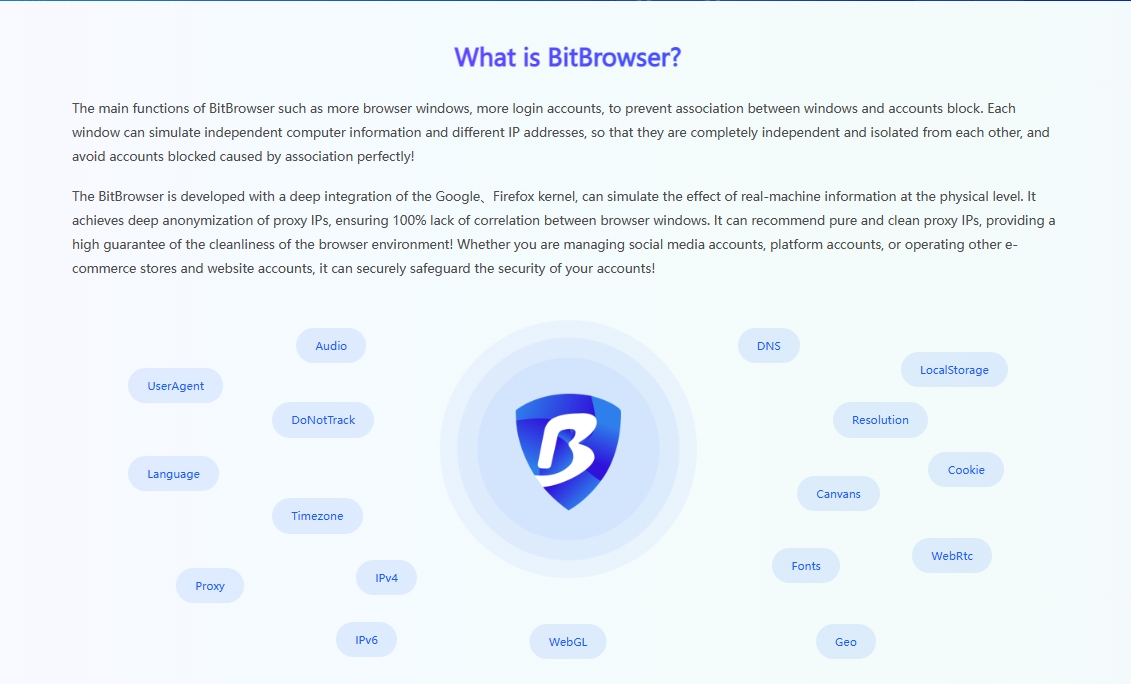
Hot Picks
How to run Facebook ads in 2025? Ideas

Hot Picks
How to promote on Amazon? Sharing various promotion methods

Hot Picks
Choose BitBrowser for fingerprint browsers, and look for the only official website: bitbrowser.cn
8 SEO optimization strategies, it is recommended to understand
Time: 2024-07-27 17:31 Click:
In a rapidly changing digital world, the SEO landscape of 2024 is very different than it has ever been. With the explosion of information and increasing competition, it has never been more important to stay focused and strategic. Therefore, we must be clear about one thing: what factors are crucial in the current SEO strategy? How can we use these factors to improve the visibility and traffic of the website?
Below, we will take a deep dive into several key factors that affect the success of modern SEO and provide corresponding optimization strategies.

1. Insights into search intent
With the rapid development of machine learning and artificial intelligence technology, Google is increasingly focusing on understanding the context of search queries and returning results that are highly matched to user intent. Therefore, advanced keyword research and precise selection have become the core of SEO strategy.
Before investing time and resources in optimizing a keyword, be sure to deeply analyze the performance of the keyword in the search results to ensure that your content is highly aligned with the search intent.
2. The foundation of technical SEO
The foundation of technical SEO is to build a strong and easy-to-navigate website architecture. This not only helps guide users through your website, but also allows Google crawlers to crawl and index your pages more effectively. To optimize technical SEO, you need to conduct regular technical SEO audits and utilize various SEO tools to identify and fix potential issues. This includes but is not limited to checking status code errors, optimizing robot.txt files, resolving indexing issues, fixing duplicate content, handling broken links, etc.

3. User experience optimization
User experience (UX) is one of the key factors in evaluating the success of a website. To improve user experience, you need to focus on the needs, values, abilities, and limitations of users and optimize website design, content, and functionality accordingly.
Here are some key factors to improve user experience:
Uniqueness: Provide unique and valuable content to meet user needs.
Ease of use: Ensure that the website is easy to use and navigate, and avoid complex operation processes.
Emotional resonance: Evoke emotional responses from users through design and brand elements.
Accessibility: Ensure that website content is accessible to all users, including those with disabilities.
Reliability: Maintain the stability and security of the website and enhance user trust.
4. Mobile-first strategy
With the continued growth in the use of mobile devices, mobile-first has become an important part of modern SEO strategies. To optimize the user experience on mobile devices, you need to make sure your site is adaptable to various screen sizes and provides a clean, clear interface and fast-loading content.
Here are some mobile-first best practices:
Responsive design: Make sure your site automatically adapts to the screen size of different devices.
Optimize image loading: Use appropriate image formats and compression techniques to ensure that images load quickly on mobile devices.
Concise titles: Use short titles that are easy to read on mobile devices.
Avoid pop-ups: Prevent pop-ups from blocking content and affecting user experience.

5. Link creation
Links are still one of the most important ranking factors.
6. Conduct tests
The basic process of SEO testing is as follows:
Clarify what you are testing and why.
Develop a hypothesis, which is the result you expect the change you make to bring.
Keep records of your tests to ensure that they are repeatable.
Publish your changes and submit the URL for review through Google Search Console.
Run the test long enough to test whether your hypothesis is correct. Record your findings and any observations that may affect the results, such as changes made by competitors.
Analyze the acquired data based on the test results.
7. Track and analyze KPIs
Customer lifetime value (CLV), content effectiveness, average acquisition time, conversion goals in percentage, accurate search visibility, brand awareness in search, new and old users, average time spent on the site, revenue per thousand (RPM), and average position.
It is important to remember that these KPIs depend on your goals and intentions. Some may apply to your specific situation and website, while others may not.
8. Use SEO Optimized Browser

Google presents different content based on the user's region, and BitBrowser, as a tool focused on SEO optimization, has the ability to simulate searches by users in different regions. With this feature, we can easily understand Google's optimized display in various regions. After in-depth analysis of this data, we can more accurately grasp the performance of the website in different markets and provide accurate data support for our own SEO strategy. This helps us develop more efficient and targeted optimization plans, thereby further improving the exposure and competitiveness of the website in different regions.
Summary:
Since the Internet never expires, a large amount of information and wrong information appears in various searches every day. This article provides you with 8 commonly used SEO optimization solutions, providing each optimizer with convenient optimization solutions. BitBrowser, as the most convenient SEO optimization solution, provides many optimizers with new optimization directions. Download BitBrowser now to get 10 permanent free windows immediately.

 Multi-Account Management
Multi-Account Management Prevent Account Association
Prevent Account Association Multi-Employee Management
Multi-Employee Management



